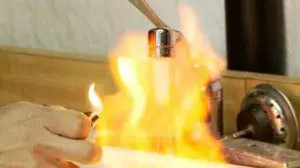
This photo has not been altered. This is an example of how fracking is affecting our water supplies.
Fracking is a commonly accepted term for hydro-fracturing, a process where water, sand and millions of gallons of toxic chemicals are injected into the earth at high pressure.
The aim of hydro-fracturing is to fracture rock formations deep underground in the hopes of liberating natural gas that would be otherwise inaccessible, and to bring it to the surface.
“With hydrofracking, a well can produce over a million gallons of waste water that is often laced with highly corrosive salts, carcinogens like benzene and radioactive elements like radium.Other carcinogenic materials can be added to the waste water by the chemicals used in the hydrofracking itself”. Source
Through the processes of fracking, our underground water supplies (artesian wells / aquifers) are being poisoned. This is occurring in every continent on earth for the purpose of extracting more fossil fuels.
Large companies are moving in on peoples property (which governments are allowing) and drilling for natural gas via fracking, as you will see from the below video’s, this process is destroying local water supplies.
The above photo is taken from the below video trailer for a documentary called GasLands. It demonstrates how a man’s property was used for fracking and how he can now turn on his home water taps and set the water a light!
GasLands Official Trailer – 3 Minutes
How does hydraulic fracturing work?
Hydraulic fracturing or fracking is a means of natural gas extraction employed in deep natural gas well drilling. Once a well is drilled, millions of gallons of water, sand and proprietary toxic chemicals are injected, under high pressure, into a well. The pressure fractures the shale and props open fissures that enable natural gas to flow more freely out of the well.
What is horizontal hydraulic fracturing?
Horizontal hydrofracking is a means of tapping shale deposits containing natural gas that were previously inaccessible by conventional drilling. Vertical hydrofracking is used to extend the life of an existing well once its productivity starts to run out, sort of a last resort. Horizontal fracking differs in that it uses a mixture of 596 chemicals, many of them proprietary, and millions of gallons of water per frack. This water then becomes contaminated and must be cleaned and disposed of.
What is the Halliburton Loophole?
In 2005, the Bush/ Cheney Energy Bill exempted natural gas drilling from the Safe Drinking Water Act. It exempts companies from disclosing the chemicals used during hydraulic fracturing. Essentially, the provision took the Environmental Protection Agency (EPA) off the job. It is now commonly referred to as the Halliburton Loophole.
How deep do natural gas wells go?
The average well is up to 8,000 feet deep. The depth of drinking water aquifers is about 1,000 feet. The problems typically stem from poor cement well casings that leak natural gas as well as fracking fluid into water wells.
How much water is used during the fracking process?
Generally 1-8 million gallons of water may be used to frack a well. A well may be fracked up to 18 times.
What fluids are used in the fracking process?
For each frack, 80-300 tons of chemicals may be used. Presently, the natural gas industry does not have to disclose the chemicals used, but scientists have identified volatile organic compounds (VOCs) such as benzene, toluene, ethyl benzene and xylene.
In what form does the natural gas come out of the well?
The gas comes up wet in produced water and has to be separated from the waste water on the surface. Only 30-50% of the water is typically recovered from a well. This waste water can be highly toxic.
What is done with the waste water?
Evaporators evaporate off VOCs and condensate tanks steam off VOCs, 24 hours a day, seven days a week. The waste water is then trucked to water treatment facilities.
What is a well’s potential to cause air pollution?
As the VOCs are evaporated and come into contact with diesel exhaust from trucks and generators at the well site, ground level ozone is produced. Ozone plumes can travel up to 250 miles.
Some news report on Fracking
NY Times – “The dangers to the environment and health are greater than previously understood.” Source
Natural Resources Defence Council – “The rapid expansion of natural gas drilling across the nation endangers human health and the environment” Source
Earth Times – “Dangers of fracking go beyond poisoned water supplies and earthquakes” Source
To close, below is a quote from journalist Liz Hayes, from a 60 Minutes Australia piece on Fracking, broadcast May 2011:
“How’s this for a raw deal? A big company marches onto your land, sinks a well without your permission and then proceeds to threaten your livelihood. And it does it all with the consent and approval of the Australian government. Now this would be bad enough if it was happening halfway across the world in some tin pot dictatorship. But this is happening in our backyard. And it’s our laws and our politicians who are letting it happen.” ~ Source
To learn more about fracking, please check out this Hydraulic Fracturing FAQ.

If you've ever found value in our articles, we'd greatly appreciate your support by purchasing Mindful Meditation Techniques for Kids - A Practical Guide for Adults to Empower Kids with the Gift of Inner Peace and Resilience for Life.
In the spirit of mindfulness, we encourage you to choose the paperback version. Delve into its pages away from screen glare and notifications, allowing yourself to fully immerse in the transformative practices within. The physical book enriches the learning process and serves as a tangible commitment to mindfulness, easily shared among family and friends.
Over the past few years, Wake Up World has faced significant online censorship, impacting our financial ability to stay online. Instead of soliciting donations, we're exploring win-win solutions with our readers to remain financially viable. Moving into book publishing, we hope to secure ongoing funds to continue our mission. With over 8,500 articles published in the past 13 years, we are committed to keeping our content free and accessible to everyone, without resorting to a paywall.






